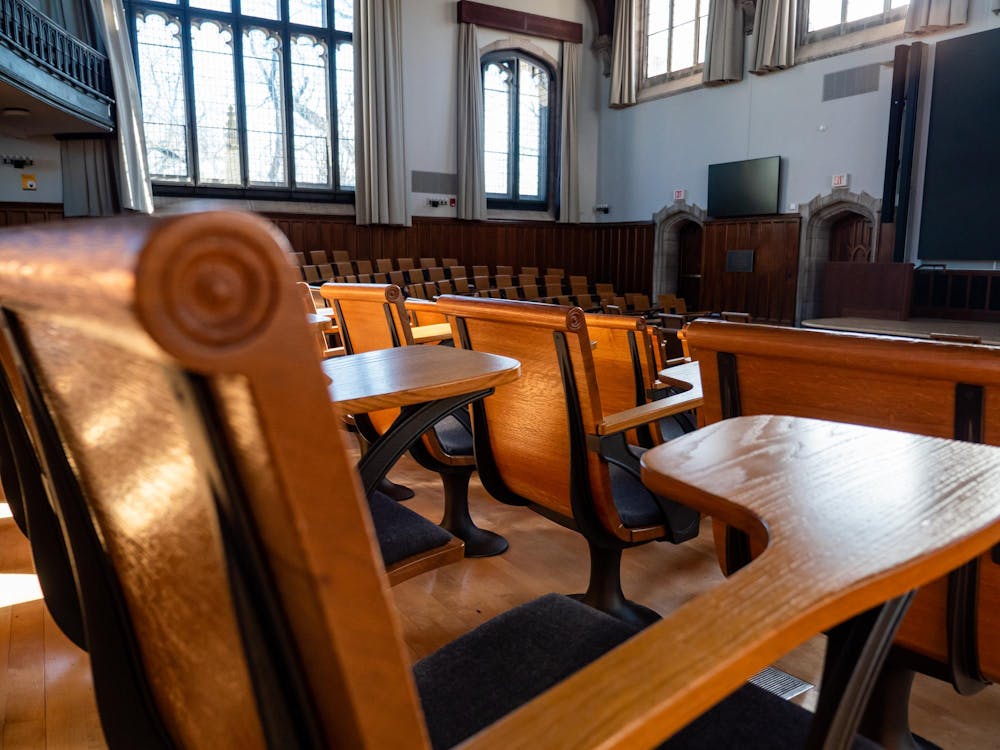Air quality tests performed in the Forbes basement library measured radon levels of 7.5 picocuries per liter (pCi/L), University officials announced in a press release Wednesday. The Environmental Protection Agency (EPA) recommends that steps be taken to lower radon levels of 4.0 pCi/L or higher inside buildings.
The Forbes library will remain closed until the radon remediation work is completed, University spokeswoman Cass Cliatt '96 said, probably at least until the end of this school year.
Radon is a naturally occurring radioactive gas that cannot be seen, smelled or tasted. It is the leading cause of lung cancer in nonsmokers and is responsible for more than 20,000 deaths every year, according to the EPA website.
The University is in the process of consulting with radon and remediation experts who are advising them on what steps should be taken to reduce the radon levels in Forbes and on what other testing, if any, should be done on campus.
"The type of remediation will depend on the source of the radon," Cliatt said. "We're continuing to do testing in the Forbes library and trying to understand what caused the elevated radon levels." Remediation techniques involve fixing the sources of the radon; this may include installing new ventilation systems or sealing cracks in the foundation of Forbes.
An engineering class first detected the abnormal concentrations while doing a lab on radioactive decay. Buildings on campus, including Forbes, were last tested for radon in the mid 1990s, Cliatt said. At that time, some remediation work was done in the Forbes basement to decrease radon levels.
No testing has been done since then because University policy is typically not to retest unless there are changes that might affect the air quality. Cliatt said she could not speculate about if or when the radon levels would have been detected had the students not performed the experiments.
Though the students' lab used equipment designed to measure the rate of radon decay, not definitive radon concentrations, the data from the Forbes library was an entire order of magnitude above their results from other buildings on campus.
To determine exact radon levels, the University conducted tests with the appropriate equipment and confirmed this week that the Forbes library had unusually elevated levels of radon.
University testing using a RAD7 radon detector showed that the Forbes basement computer room had 2.4 pCi/L of radon and the Edwards basement had levels between .8 and 1.9 pCi/L. The average indoor radon level in the United States is 1.3 pCi/L, while about 0.4 pCi/L is found in the air outdoors.
The Forbes library, with a 7.5 pCi/L concentration, was the only University area that tested above the EPA's threshold of 4.0 pCi/L. The EPA website also warns that radon levels less than 4.0 pCi/L can still pose a risk.
Sue Dupre, University health physicist, said in a University press release that the radon levels in Forbes pose a "very small" risk to student health.

"For a student who spent three hours daily in the [Forbes] library every day of the nine-month academic year, we estimate that the risk of developing cancer would be only about .0025 percent greater than the same person exposed to the average indoor radon level of 1.3 pCi/L," Dupre said.
The risk from elevated radon levels can increase dramatically with prolonged or lifetime exposure, however.
The likelihood of nonsmokers contracting lung cancer from lifetime exposure to a level of 4.0 pCi/L would be roughly equivalent to the risk of dying in a car crash, according to the EPA website, and the risk would be five times higher for smokers.
If 1,000 nonsmokers were exposed to 8 pCi/L of radon over a lifetime, about 15 people would get lung cancer. If a group of 1,000 smokers was exposed to similar radon levels, 120 people in the group would get lung cancer, according to the EPA.
Megan Schoendorf '10, a student who participated in the lab, said she was not too worried about the effects of the elevated radon levels.
"The results were somewhat concerning," Schoendorf said in an email. "[But] we are all exposed to a certain base amount of activity per year — that's what it means to live on this planet ... getting a little more once in a while doesn't strike me as a huge problem."
Thomas Nyquist, director of engineering facilities, said in the University statement that other campus facilities will be tested for radon, beginning this summer. The University will also consult with experts as they reevaluate their testing system, Cliatt said.
"I am happy ... that our results have spurred the University to reassess the radon levels all over campus and to come up with a plan to regularly monitor them," Maya Srinivasan '10, a student in the engineering class, said in an email. "It's awesome that they have taken our concerns so seriously."







